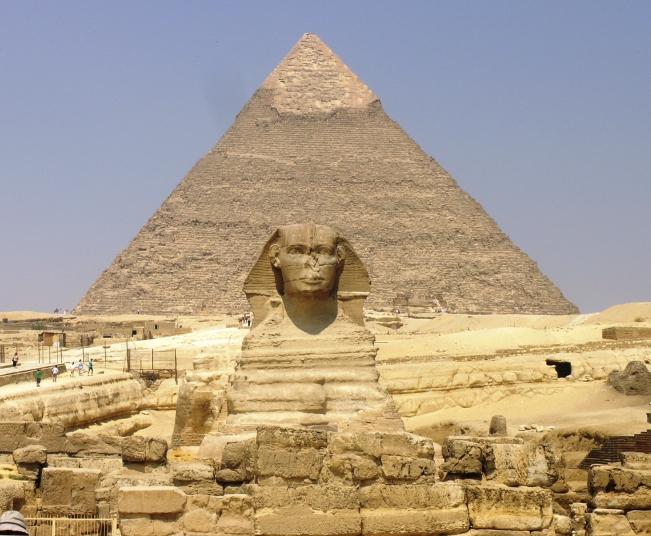A masterpiece in every sense, the Great Pyramid of Giza has truly earned the title “Wonder”. The Pyramid is built with extreme precision that even modern technology cannot replace it. The Pyramids of Giza were built to endure an eternity, and the tombs have done just that. The Pyramid is relic of the Old Kingdom of Egypt. The building process started circa 2550 B.C. by the Pharaoh Khufu. He built the first, and the largest of the three Pyramids, a process his son, Khafre continued with the building of the second Pyramid, a necropolis that also included the Sphinx. The third Pyramid is built by Pharaoh Menkaure in circa 2490 B.C. and it is much smaller than the first two. All three Pyramids are part of the complex that includes temples, palace, solar boat pits and much more.
Facts that will vow you
In order to truly understand the magnitude of the Pyramid, let’s look at some of the known facts that will blow your mind.
– There are roughly 2,300,000 stone blocks weighting 2 to 30 tons in the construction of the Pyramid.
– All the three Pyramids are precisely aligned with the Constellation of Orion.
– The temperature within the Pyramid is constant, 20 Degrees Celsius, 68 Fahrenheit, which is the average temperature of the Earth.
– The casting stones compositing the outer mantle are all polished and flat with extreme accuracy of 1/100 of an inch, and they are all 100 inches thick.
– The origin of the mortar used is unknown. Despite multiple analyses, the material cannot be reproduced with modern technology.
IMG-L:http://fc07.deviantart.net/fs70/f/2012/151/f/d/giza_pyramid_diagram_by_kiraonthenetz-d51r5xu.png;
– The Pyramids of Giza are the most accurately aligned structure in the world, facing true north with a degree of error of just 3/60th. It is worth noting that the position of the North Pole changes, as the Pole moves and at one time, the Pyramid was exactly aligned.
– Another fact linked with the perfect positioning of the Pyramid. It is located at the center of the land mass of the Earth. The east/west parallel and the north/south meridian interest in just two places on the Earth, one of which is at the Pyramid.
– The Giza Pyramid is the only Pyramid in the world built with four faces that are concave.
– The centers of the four sides form the only 8 sided Pyramid in the world. This effect, made with such precision is visible only from the air.
– The weight of the Great Pyramid of Giza is approximately 5,955,000 tons. If you multiple the value by 10^8, the equation gives reasonable estimate of the mass of the Earth.
– The southern shaft located within the King’s Chamber pointed to Al Nitak, a star in the constellation of Orion. The Egyptian god Osiris is associated with the constellation. No other star aligned with the southern shaft.
– If you measure the perimeter of the bottom of the granite coffer, and then multiple it by 10^8, the result is the sun’s radius.
– The greatest pyramid, the first one build by Khufu is 481 feet tall, and for 3,800 years it was the tallest structure in the world.
– The relationship between the number Pi (p) and the number Phi (F) is expressed in the fundamental proportions of the Pyramid of Giza.
– The opening of the joints is just 1/50th of an inch wide, which is considered extremely precise.
Giza preserves Ancient Egypt Civilization
The Great Pyramid helped preserve the culture and the civilization of Ancient Egypt, allowing archeologists to explore a world that has long been vanished from the face of the Earth.
While many people consider the Pyramid a cemetery, it is much more than that. The tombs are decorated with scenes of life in Egypt, showing how the Ancient Egyptians lived.
Inscriptions and texts within the Pyramid have allowed researchers to study the grammar and the language of Ancient Egypt. The walls within the Tomb are rich with pictures, illustrations, inscriptions and much more, that they allow a study for every aspect of the life in Ancient Egypt.
Construction theories
The Pyramid of Giza consists of more than 2.3 million blocks. Based on estimation of the building, in order for the Pyramid to be built in 20 years, the process required installing of 800 tons of stone every day. Or in other words, 12 of the blocks should have been placed into place each hour, 24 hours per day. It is believed that Egyptians transported the stones in a traditional way. Or they cut the blocks by hammering wooden wedges into them. The wedges were soaked in water and once the water was absorbed, the wooden wedge expanded and caused the rock to crack. Once cut, the blocks were carried by boat.
However, aside from the main theory, there are many alternative, contradictory theories. For example, many scientists disagree whether the stone blocks were lifted, dragged or even rolled into the Pyramid. According to the Greeks and their theory, slaves were used. However, modern theory suggests that the construction was done by skilled workers. One theory suggests that workers were organized by hierarchy. There were two groups of 100,000 men, divided into five smaller groups of 20,000 people, further divided according to the skills of the construction workers.
The mystery of the construction is the planning. One theory suggests that the Egyptians laid out parts of the plan on the ground. They used 1-to-1 scale which would create a modern diagram that can serve to generate the architecture of the Pyramid. According to this theory, the planning they used was the reason for the precision.
In a modern study, few scientists have estimated that the building required an average workforce of 14,567 construction workers at any time, and a peak of 40,000.



